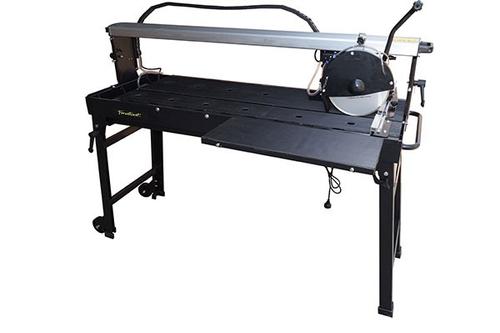Bridge tile saw or the sliding table, which one is better? This is a question I often see and let me explain the pros and cons of each.
Accuracy:
If you compare a brand new bridge tile saw and a sliding table saw you will find that they are both precise and cuts smooth. In fact, the sliding action is slightly more stable since the guideways are farther apart.
However, if you do not clean and maintain the tool in good condition, the sliding table will lose its accuracy. This is because the fine dust that is produced while cutting tiles gets mixed with water and forms a paste. If you let this gum up the table guideways or rollers, soon it will erode the guides and eventually will end up with a lot of play.
The bridge tile saw is less prone to this since less amount of contaminated water reaches the bridge. In either case, it is important that you use sufficient amount of water and clean the power saw immediately after use.
Tile Size
The bridge type works best for large size tiles whereas the sliding type is best suitable for smaller tiles.
In the case of a heavy granite or marble blocks, you can imagine that it is easy to move the blade over the work that sliding the table.
In addition to this, the bridge saw is the best option for extra wide tiles. Imagine am extra-wide tile that is protruding from the side of the table. You can easily cut through the center of a wide tile using a bridge tile saw. However, this is often not possible on a rolling table type, because most of these saws have their blade head fixed on a pole that is attached on the side of the table. The tile will clash with the side pole preventing any further movement of the table.
Type of Cuts
Bridge type is the best option for long rip cuts while the sliding kind has the advantage of plunge cuts. A simple technique that tiling contractors often use on a sliding table saw is to cut the long tiles until half the way. Then rotate the work-piece 180 degree and carefully align to cut the other half to achieve a long rip-cut that is otherwise not possible.
Here is a comparison table that shows the difference between a bridge tile saw versus sliding table tile saw.
| Bridge Tile Saw | Sliding Table |
| The tile is stationary and the blade moves over the tile. | The table is moved across the revolving blade. |
| Works best for large tiles. | Better choice for smaller tiles. |
| Accommodates wider tile. Possible to cut wider tiles that extends on both sides of the table. | The side pole on which the blade is mounted prevents you from cutting extra wide tiles. |
| Safe and easy to cut bevels up to 45-degrees. | Holding the table on either side and sliding it across a beveled blade is intimidating. |
| Since less dirt and water falls on the bridge, the overhead tile saw is more accurate in the long run. | Contamination gets accumulated on the guideway causing the jerky table movement and may even damage the slide. |
| Works best for rip cuts. Difficult to cut notches etc. | Easy to do plunge cuts and notches. |
Conclusion:
Personally, I would recommend sliding tile saw for most small jobs and the bridge type for professional contractors who are working on large projects.
You can visit our website for more information and testing videos. Or contact us at 1300281198 to talk to our friendly staff member for any questions.

